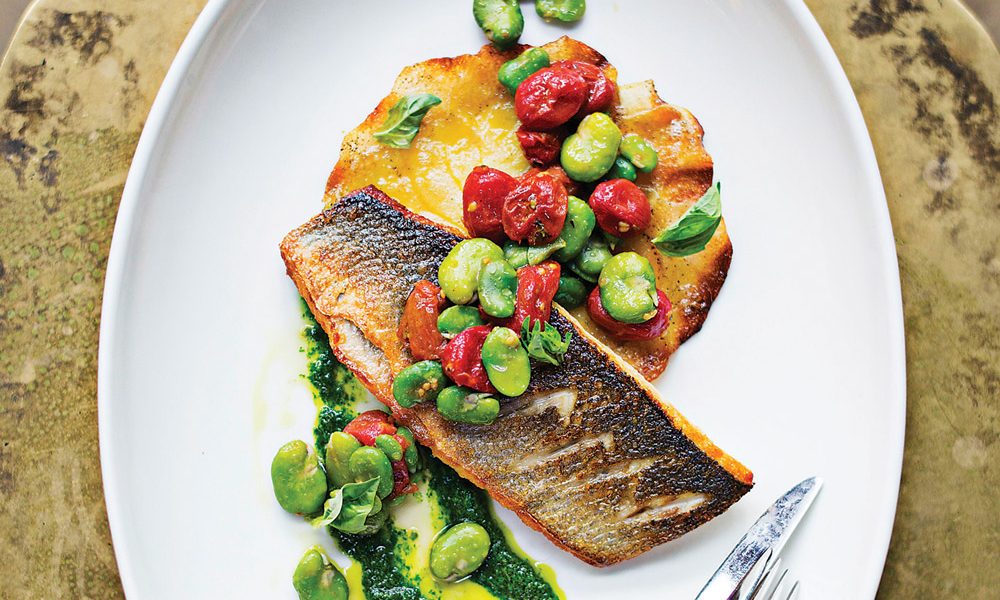Food & Drink
Happy Travels
Pazo gets a menu makeover.
When Cindy Wolf and Tony Foreman, co-owners of Foreman Wolf Restaurant Group, imagined Pazo, it was a time when Harbor East was just beginning its renaissance from urban no-man’s land to dining destination. When it opened, with its focus on tapas inspired by Mediterranean peasant plates, and a Patrick Sutton-realized ambiance that awed, Pazo was a revelation. In short, eating at Pazo—a Catalan word meaning “grand house”—was as close to experiencing sunny European coastal climes as one could come without wielding a passport.
Fast forward 10 years, and it’s hard to believe that Pazo is one of the grande dames of Harbor East. Despite its years, Pazo is still the fun and festive sequel to the more serious scene surrounding some of Foreman Wolf’s other outposts, including Charleston and Petit Louis Bistro.
To keep things fresh, in June, Foreman Wolf introduced a menu that aims south of Rome and tapped the talents of Julian Marucci, who is Pugliese (and was already working in-house at Cinghiale), to serve as executive chef.
Wherever Pazo takes us, we’re happy to go along for the ride because we know we’ll be in good hands. From the welcoming valets who whisk us off Aliceanna Street to a waitstaff that strikes the sweet spot between overly attentive and laissez-faire, and a kitchen crew that takes an almost academic interest in why we haven’t eaten every morsel off a particular plate (more on that later), service is rarely anything other than faultless.
The new menu kicks off with a series of stuzzichini (starters), while the middle of the menu highlights a selection of Neapolitan pizzas, and the lower portion of the menu is a price-fixed, three-course, $45-per-person affair highlighting hand-formed pastas and wood-fire grilled meats and seafood. (One caveat, as is the case with many spots these days, seasonal specialties flit on and off the menu, so don’t get overly attached to any one dish or preparation.)
On our first visit, we stuck to the starters, including the wood-grilled octopus—a clever combination of smoked potato and celery heart, with a whisper of heat from some chili oil—before moving on to an exquisite P.E.I. cold mussel salad with green beans and crushed Marcona almonds. We also sampled the salmon crudo, bite-sized chunks of Vancouver salmon served tartare and mixed with chili oil, cucumber, celery root, and pistachios. While the fish was fresh, it lacked flavor, so after a bite or two, we left most of it uneaten. (Still, we were impressed when the waitress, in an effort to report back to the kitchen, showed an earnest interest as to why we hadn’t finished the dish.)
Pazo is still the fun and festive sequel to the more serious scene surrounding some of Foreman Wolf’s other outposts.
Other wow-worthy dishes were the house-made ricotta (imagine eating a cloud) drizzled with honey, and punctuated by almonds and arugula, as well as a bowl of burrata (a creamier version of mozzarella) flown in from Puglia twice weekly and tossed with heirloom cherry tomatoes and fresh basil.
On a second visit, we followed the price-fixed route (including a starter, a small portion of pasta, and a choice of fish or meat). Among our favorites was the golden-and-red-beet salad with house-made ricotta, arugula, and walnut pesto. The sweet beets, paired with the ricotta and earthier flavors of arugula and slightly piquant pesto, could make a root-vegetable convert out of anyone.
Among the pastas, the real stunner was the house-made basil fettucine bathed in a spicy tomato sauce and strewn with chunks of sweet Maryland crab. But our favorite dish of the night, hands down, was the grilled branzino. The delicate fish dish came with a complement of fanned potatoes, fava beans, roasted cherry tomatoes, and basil purée, and showcased a crisp, crackly skin thanks to its preparation in the wood-fired oven.
Because we wanted to sample all aspects of the menu, we returned to try Pazo’s weekday happy hour when select pizzas cost a cut-rate $5 in the lounge and bar. On this visit, we split the verde pizza, an inventive take on a farmers’ market pizza, topped with fava beans, snap peas, pesto, arugula, and ricotta, and the funghi pizza with forest mushrooms, fontina, and white truffle béchamel. Both were delicious and filling, though that didn’t prevent us from ordering a luscious slice of dark chocolate mousse cake, served with a silky Sicilian pistachio gelato on the side.
Though the menu has changed, Pazo’s new wine list remains epic, with the regions of Puglia, Sardinia, and Calabria well represented. A favorite glass of wine was the Tenuta delle Terre Nere, with red grapes cultivated from the volcanic soils of Mt. Etna. In the final analysis, Pazo is the epitome of evolution. At 10 years and counting, we’d say the girl is still going strong. As the saying goes, there ain’t nothing like a (grande) dame.
